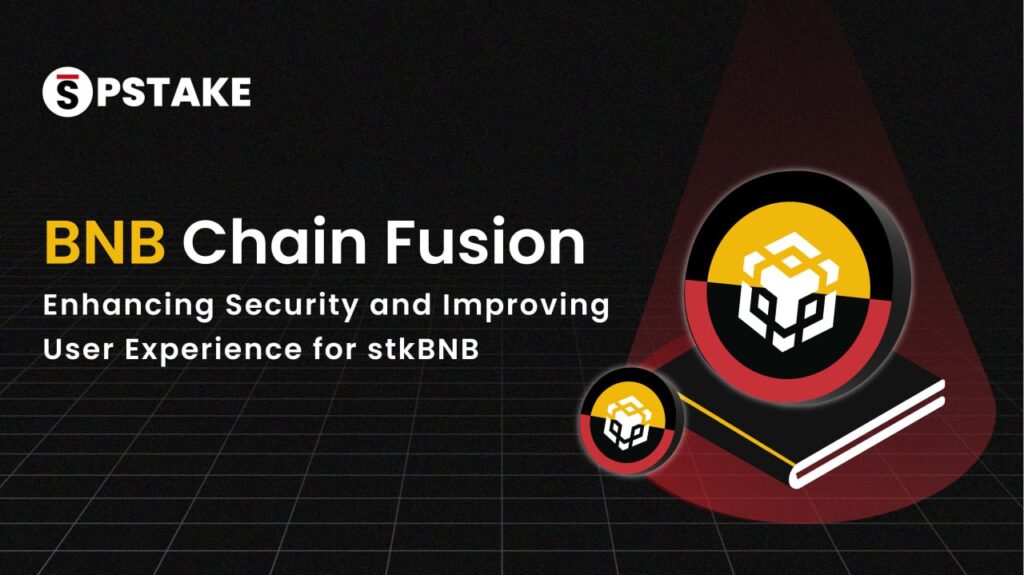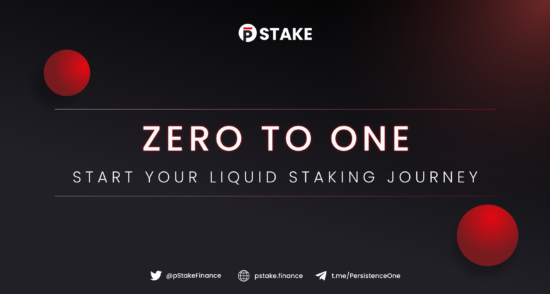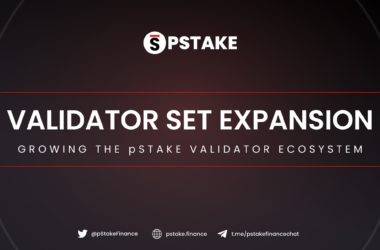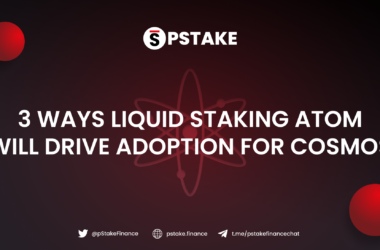This article aims to provide all necessary information required to begin your zero to one journey with pSTAKE. If you have any further questions after reading, please refer to our documentation or reach out in our Telegram community group.
Contents
- Introducing pSTAKE
- How Does it Work? User Example
- Progress So Far
- $PSTAKE Token Roles
- Get Started: pSTAKE User FAQ
pSTAKE user video tutorials are available here (for Keplr users) and here (for Ledger users).
1. Introducing pSTAKE
Proof-of-Stake (PoS) is an increasingly popular consensus mechanism that provides robust security to decentralized networks via staking. Participants, or stakers, are required to lock up PoS assets (such as ATOM, XPRT etc.) on-chain in exchange for staking rewards.
While staking helps to address concerns regarding resiliency and provides an economic incentive for participants to keep the networks secure, the asset illiquidity that results from staking is a pain point plaguing the PoS ecosystem. Staked PoS assets are locked and have no additional utility other than staking. This is a barrier to staking for those who would prefer to keep their assets liquid for trading, holding with flexibility, or for use in DeFi for potentially greater yields.
Via liquid staking, however, pSTAKE allows users to access the liquidity of their staked PoS assets while still securing the underlying network, simply by staking through the pSTAKE application.
By using pSTAKE, users can earn network staking rewards while also receiving stkTOKENs (1:1 pegged representatives of the underlying assets). stkTOKENs are issued once a user has staked a PoS asset using pSTAKE and can be freely transferred, traded, or used to generate additional yield via DeFi protocols.
2. How Does it Work? User Example
Alice holds 100 ATOM tokens. She can’t decide whether to stake her ATOM to receive staking rewards in return for helping to secure the network, or use her ATOM in DeFi for potentially greater yields. Using pSTAKE, Alice can do both.
Alice heads to the pSTAKE application and deposits her 100 ATOM. In return, she receives 100 pATOM, representing a claim on the 100 ATOM deposited onto the pSTAKE platform. As long as Alice has 100 pATOM in her possession, she can withdraw her initially deposited 100 ATOM (1:1) from the pSTAKE protocol by burning (or unwrapping) her pATOM balance.
However, Alice would rather stake her pATOM via pSTAKE to receive Cosmos network staking rewards while keeping her assets liquid.
Once staked, Alice’s 100 pATOM is effectively burned and converted into 100 stkATOM (1:1 pegged ERC-20 token). Alice is now free to leverage her newfound 100 stkATOM within Ethereum DeFi to earn even more rewards, on top of the staking rewards she is receiving.
After depositing her 100 stkATOM with an equivalent amount of ETH into the stkATOM-ETH liquidity pool on SushiSwap, for example, Alice makes a portion of the trading fees generated by the pool.
Alice is therefore now earning dual yields: Cosmos network staking rewards in addition to DeFi yield on SushiSwap.
3. Progress So Far
pSTAKE has launched liquid staking support for Cosmos’ ATOM and Persistence’s XPRT tokens, with support for more assets such as ETH (Ethereum), SOL (Solana), and other Cosmos-based assets coming soon. Since launch, more than $32M of ATOM and XPRT has been staked by pSTAKE users.
pSTAKE users have also added a combined total of $26M+ in liquidity to the stkATOM-ETH and stkXPRT-ETH pools on SushiSwap, earning both staking rewards and trading fees (in addition to retroactive $PSTAKE rewards, discussed below).
In November, pSTAKE closed its $10M strategic funding round led by Three Arrows Capital, Sequoia India, Galaxy Digital, and Defiance Capital to bootstrap the protocol. pSTAKE’s initial safelisted validator set, comprising top global validators, was also announced. In addition, pSTAKE has now been audited by three of the industry’s top auditing firms – PeckShield, Solidified and ConsenSys Diligence.
Currently, pSTAKE issues 1:1 pegged ERC-20 liquid staking representative tokens on the Ethereum network, and a Cosmos-based implementation of the pSTAKE protocol is also in the works. Other current focuses of the pSTAKE team include bootstrapping DeFi use-cases of stkTOKENs (such as lending/borrowing, perpetuals, yield farming etc), and the $PSTAKE token TGE following the concussion of the $PSTAKE public sale on CoinList (TGE details to be announced at a later date).
4. $PSTAKE Token Roles
$PSTAKE is an ERC-20 token that provides its holders with a two-fold benefit:
- Participation in protocol improvement proposals through voting
- Participation in protocol security
The $PSTAKE token functions as the governance and incentivisation/dis-incentivisation token of the pSTAKE protocol. $PSTAKE holders are incentivised to participate in the protocol’s governance to ensure its long-term success and security by staking $PSTAKE via the pSTAKE staking contract.
$PSTAKE tokens will also be used as a dis-incentivization token in case stakeholders staking $PSTAKE act maliciously or are unable to perform their respective duties appropriately.
At its core, the $PSTAKE token aligns stakeholder incentives with pSTAKE’s liquid staking ecosystem. Read more about pSTAKE’s various stakeholders here.
Details regarding $PSTAKE tokenomics will be released in an upcoming article.
5. Get Started: pSTAKE User FAQ
You can stake your assets via pSTAKE here: https://app.pstake.finance
Read below for more guidance.
Which assets does pSTAKE support?
pSTAKE currently supports liquid staking for Cosmos’ $ATOM and Persistence’s $XPRT, with support for more major PoS assets (including SOL, ETH and other Cosmos-based assets) coming soon.
How do I acquire assets to use on pSTAKE?
ATOM and XPRT can be acquired on a variety of centralized and decentralized exchanges.
See the list of ATOM-supporting exchanges here and XPRT-supporting exchanges here.
Which wallet/s do I need to begin using pSTAKE?
Since stkTOKENs are ERC-20 tokens issued on the Ethereum network, you will need to have MetaMask installed on your browser (Chrome browser is recommended).
You will also need Keplr wallet installed in order to deposit your ATOM or XPRT tokens from Keplr to pSTAKE for wrapping.
How do I wrap and stake my assets on pSTAKE to receive stkTOKENs?
There are dedicated video tutorials to guide you through the process, whether you use Keplr or Ledger.
Keplr tutorial:
Ledger tutorial:
Once you follow the first two steps outlined in the videos, you will see your stkTOKENs in your MetaMask wallet. While also earning staking rewards, these stkTOKENs are free to be used within DeFi protocols on Ethereum for additional yield (step 3 in the tutorial videos above).
Can I use my stkTOKENs in DeFi currently?
Yes, you can. pSTAKE has whitelisted the stkATOM-ETH and stkXPRT-ETH pools on Sushiswap to enable users to earn both staking rewards and trading fees by providing liquidity and using pSTAKE’s Stake LP function. More pools will be whitelisted in the near future.
For detailed guidance on how to provide pool liquidity and use pSTAKE’s Stake LP function, see the video here (using Keplr) or here (using Ledger), or refer to the documentation page here.
Are there any other incentives to provide liquidity to the stkTOKEN pools on SushiSwap?
Yes. Bootstrapping liquidity for stkATOM and stkXPRT is a current priority of pSTAKE. In order to accelerate progress, pSTAKE previously announced a retroactive liquidity mining campaign for liquidity providers of stkTOKEN pools on SushiSwap. 6 Million $PSTAKE tokens will be distributed to LPs who stake their LP tokens via pSTAKE’s Stake LP function before TGE (date yet to be announced).
Read the full details here: https://bit.ly/pSTAKErewardsLP
Where can I find answers to questions regarding the protocol?
A more technical FAQ section can be found in our documentation here.
I have another question that hasn’t been answered here. Where can I go for support?
Feel free to reach out in our Telegram community group and our admins or team will gladly assist.
About pSTAKE
pSTAKE is a liquid staking protocol that unlocks liquidity for your staked assets. With pSTAKE, you can securely stake your Proof-of-Stake (PoS) assets, participate in protocol improvements and security to earn staking rewards, and receive staked underlying representative tokens (stkASSETs) which can be used to explore additional yield opportunities across DeFi.
At present, pSTAKE supports Binance Chain (BNB), Cosmos (ATOM), Persistence (XPRT), and Ethereum (ETH) networks’ native tokens, with a view to support more chains and assets in the future (SOL, and AVAX).
Developed by Persistence
Persistence is a Tendermint-based, specialised Layer-1 network powering an ecosystem of DeFi applications focused on unlocking the liquidity of staked assets. Persistence facilitates the issuance and deployment of liquid-staked stkASSETs, allowing users to earn staking rewards while participating in DeFi primitives, such as lending/borrowing and liquidity provisioning on DEXs.
Persistence aims to offer a seamless staking and DeFi experience for PoS (Proof-of-Stake) users and enable developers to build innovative applications around stkASSETs.
Join Our Movement
Twitter | LinkedIn | Telegram | YouTube | Reddit | [email protected]










